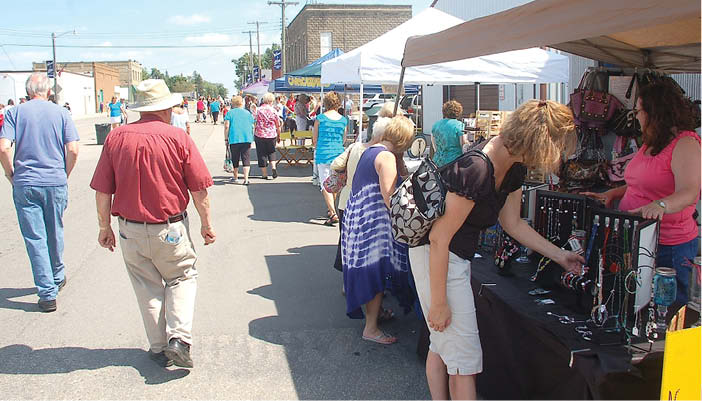Every summer, small towns around the United States participate in time honored, cherished traditions. For the residents of Ulen, Minnesota, August means Turkey BBQ Days. 2013 marks the 53rd annual Turkey BBQ with a wide variety of events held from August 15 – 17. The highlight of the festival is of course the turkey, which will be barbecued on Saturday from 3:30 – 6:00pm on “the world’s largest spit.” An estimated 3,000 pounds of turkey will be served to attendees from all over the region.
History of Ulen:
According to Dale Holman, Ulen Historian, the town was named after first homesteader Ole Ulen, who settled north of the current city in 1873. Like many towns in the Red River Valley, the area grew after the railroad came to town, leading to the incorporation of Ulen into a village in 1886. According to the United States Census, the population of Ulen was 547 in 2010. Unlike many small towns that have seen declining populations over the years, the population has stayed over 500 since 1980, topping out at 590 in 1920.
Holman has lived in Ulen on and off for 66 years. “It’s my home,” he said, adding that he most enjoys the small town, friendly atmosphere. Long-time residents like Holman have seen Ulen progress and change over the years. “We’ve lost some small businesses,” he said, “but we also have some large ones that keep the town going.” In particular, Holman cites the West Central Elevator and Braseth Construction and Sales as large contributors to Ulen’s solid economic base. West Central is one of the largest elevators in the area, shipping out 75 unit trains (comprised of 100 cars each) of grain each year. In addition, the elevator employs over one hundred people. Braseth Construction and Sales and its corresponding lumberyard employ 75-100 workers.
Another prominent staple in Ulen is the school, an addition to which was completed during Minnesota Governor Jesse Ventura’s administration. “The school is doing quite well despite challenges with declining enrollment,” said Holman. Ulen has been consolidated with Hitterdahl for quite some time, and will begin consolidating in athletics with Norman County East beginning next year.
A little known gem in Ulen may be their museum. Located on Main Street, the museum houses over 4,000 items that have been donated by various sources around the state. “We have many items from the 1900s,” Holman explained. “I recommend everyone stop by and check it out. It’s really quite amazing.”
History of the Turkey BBQ:
According to Holman, Turkey Days began in 1961 in response to a state push for more local celebrations. “The idea came from a fellow from Aneta, ND who had experienced their Turkey Days,” he explained. “The city council checked it out and decided it would be a good idea for the area.” For the first barbecue, the blacksmith in town made 6’ rods that were turned by small motors. Turkeys were put to flame at 4:00 or 5:00am. “In the 70s and 80s, hundreds of turkeys were grilled on a spit one block long,” Holman said. “We don’t barbecue quite as many turkeys anymore, but it’s still a very popular event.”
Regardless of the changes to the festival over the years, the excitement that accompanies the barbecue has persevered. New events are added to the weekend every year, and2014 promises to be no different. Turkey Days will kick off with a Titans Athletic Department Gold Scramble on Friday morning, followed by the Children’s Theater production of “Camp Unbelievable.” A men’s softball game, kiddie parade, teen dance, and fireworks at dusk round out the festival’s first day.
Saturday is an amalgamation of activities throughout the day. From the 5k walk/run in the morning to a street fair, car show, and parade in the afternoon, there is something for everyone. The turkey barbecue may be the star of the show, but the supporting cast is quite impressive. Saturday finishes up with a street dance featuring Billy D and the Crystals. The festival ends with a pancake breakfast on Sunday. A full listing of events and sponsors can be viewed at www.ulenmn.com.
Turkey Facts:
· The wild turkey is the only type of poultry native to North America and is the ancestor of the domesticated turkey.
· The scientific name for the wild turkey and modern domesticated turkey is Meleagris gallopavo. The common names used for the type of turkey vary depending on the gender and age. Male turkeys are called toms, female turkeys are called hens, baby turkeys are called poults, and a group of turkeys is called a flock.
· According to the Minnesota Turkey Research and Promotions Council, Minnesota is the number one turkey producing state in the U.S., with over 250 family farmers raising approximately 47 million turkeys annually.
· Despite the prevalence of turkey consumption in November, June is National Turkey Lovers month.
· Benjamin Franklin believed that the turkey was a better choice than the eagle for the national symbol of America.
· According to the US Department of Agriculture, more than 242 million turkeys were raised nationwide in 2010, with nearly 6 billion pounds of turkey processed. Turkey sales that year topped $4 billion.
· Age is a determining factor in taste. Old, large males are preferable to young toms as tom meat is stringy. The opposite is true for females: old hens are tougher birds.



